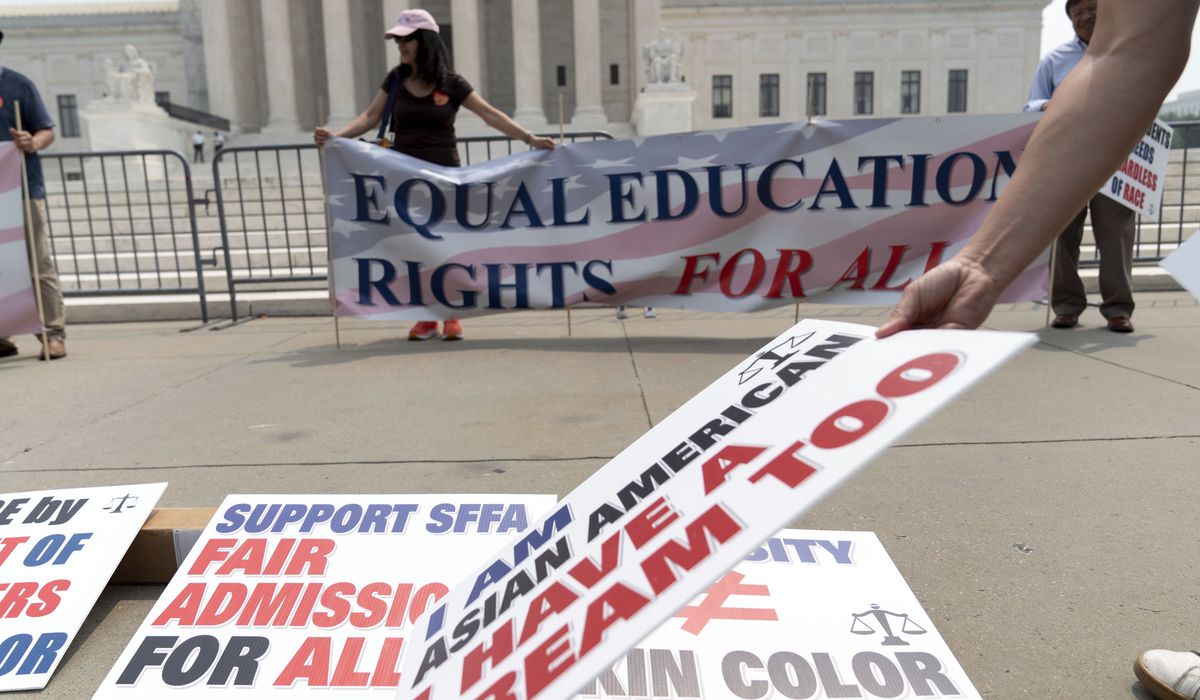


The man who led the lawsuit that upended universities’ race-based affirmative action policies warned schools against trying to find a workaround by asking Black and Hispanic applicants to focus on their race or ethnicity in their admission essays.
Edward Blum, president of Students for Fair Admissions, said that he read the Supreme Court’s ruling last week to mean that schools cannot even ask about race. That includes doing away with the race and ethnicity checkboxes that are common on applications.
Mr. Blum said applicants can mention their race in their essays, but schools should be reluctant to do too much with that information.
“It is our belief that race boxes are not allowed on college application forms,” he told The Washington Times. “A careful reading of the opinion notes that it must not be the race of an individual that is considered, but rather, the personal qualities developed as the outcomes of certain events.”
He warned schools that he’ll be watching how they comply with the ruling, including using open-records requests to public schools to get their admission data.
His comments come a week after the high court struck down the race-based affirmative action policies at Harvard University and the University of North Carolina — and just as the search for alternatives kicks into gear.
Affirmative action supporters seized on a line in Chief Justice John G. Roberts Jr.’s controlling opinion in which he said the ruling does not prohibit schools from “considering an applicant’s discussion of how race affected his or her life, be it through discrimination, inspiration, or otherwise.”
He cautioned, however, that it can’t be a way to give an advantage merely to applicants who identify as a preferred race or ethnicity.
“Universities may not simply establish through application essays or other means the regime we hold unlawful today,” Chief Justice Roberts wrote.
Harvard University, in particular, cited the chief justice’s words about applicants’ ability to talk about their race in its statement on how it would comply with the ruling.
Carolyn Shapiro, co-director of the Institute on the Supreme Court of the United States at Chicago Kent College of Law, said the ruling gives schools leeway to consider characteristics mentioned in essays that may relate to race or diversity.
“Schools can take that information into account,” Ms. Shapiro said, adding that universities may be “skittish” about where to draw the line.
Schools had defended their race-based affirmative action policies as being critical to achieve diversity, which they described as a core educational value.
The justices, in their ruling, were already debating what options schools have besides an explicit focus on race.
Justice Neil M. Gorsuch suggested schools could achieve more diversity if they ditch preferences for applications from relatives of alumni, donors and faculty, which chiefly benefit White students.
Other analysts have suggested schools use geographic or socioeconomic factors that could track closely with race.
A case involving a geography-based affirmative action program at Thomas Jefferson High School for Science and Technology, a high-profile public school in Fairfax County, Virginia, is already winding its way through the courts.
Whether — and how — schools use essays remains to be seen.
Adam Feldman, creator of Empirical SCOTUS blog, said the ruling left a “big gap” in how to interpret mentions of race in essays. That gap will be filled by lower courts right now, he said.
“You are going to see cases on affirmative action decided on the facts, to see if — to what extent — universities are using race in their acceptance processes,” Mr. Feldman said.
He said the issue could end up back before the justices, but “at this point it’s very vague.”
Curt Levey, president of the Committee for Justice, said he expects schools to try to “cheat” on the high court’s ruling.
“But Roberts did say that schools can’t do indirectly, using essays, what the Court said they can’t do directly,” Mr. Levey said. “One thing is for sure — we can expect to see a lot of litigation addressing exactly when facially race-neutral admissions criteria are being used as a cover for illegal discrimination.”
• Stephen Dinan can be reached at sdinan@washingtontimes.com.
• Alex Swoyer can be reached at aswoyer@washingtontimes.com.
